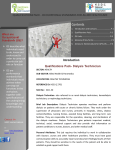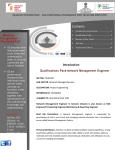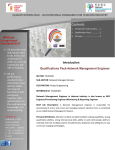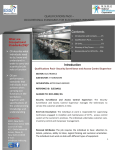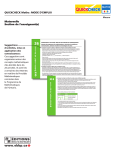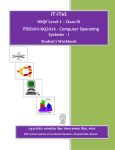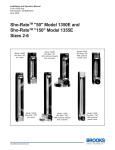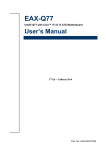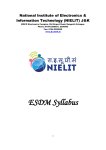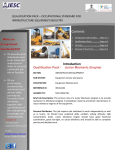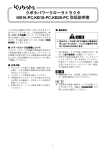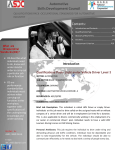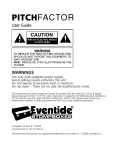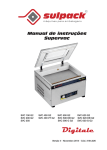Download Access Controls Installation Technician | Now
Transcript
QUALIFICATIONS PACK - OCCUPATIONAL STANDARDS FOR ELECTRONICS INDUSTRY Contents 1. Introduction and Contacts.…….P1 2. Qualifications Pack……….….......P2 3. OS Units……………..…..…….……….P3 What are Occupational Standards(OS)? OS describe what individuals need to do, know and understand in order to carry out a particular job role or function OS are performance standards that individuals must achieve when carrying out functions in the workplace, together with specifications of the underpinning knowledge and understanding Contact Us: ESSCI, New Delhi Electronics Sector Skills Council of India 422, Okhla Industrial Estate, Phase-III, New Delhi-110020 E-mail: [email protected] 4. Glossary of Key Terms ……….…P18 5. Nomenclature for QP & OS…..P20 Introduction Qualifications Pack-Access Controls Installation Technician SECTOR: ELECTRONICS SUB-SECTOR: IT Hardware OCCUPATION: After Sales Support REFERENCE ID: ELE/Q4608 ALIGNED TO: NCO-2004/ NIL Access Controls Installation Technician: Also called ‘Access Control Device Installer’, the Access Control Installation Technician provides after sale support services for access control devices and systems such as point of sale scanners, finger print or iris scan. Brief Job Description: The individual at work is responsible for installing the access control system at the customer’s premises. The individual undertakes site assessment, installs the hardware and integrates the system to meet customer’s requirement. Personal Attributes: The job requires the individual to have: ability to build interpersonal relationships, patience, listening skills and critical thinking. The individual must be willing to travel to client premises in order to install equipment at different locations. 1 Qualifications Pack For Access Controls Installation Technician Job Details Qualifications Pack Code ELE/Q4608 Job Role Access Controls Installation Technician Credits(NVEQF/NVQF/NSQF) TBD [OPTIONAL] Sector Electronics Sub-sector IT Hardware Occupation After Sales Support Job Role Role Description NVEQF/NVQF level Minimum Educational Qualifications Maximum Educational Qualifications Training Experience Applicable National Occupational Standards (NOS) Version number 1.0 Drafted on Last reviewed on 18/01/14 24/03/14 Next review date 24/03/15 Access Controls installation technician Also called, ‘Access Control Device Installer’ Undertaking site assessment, installing the access controls system; installing the scanning equipment; and configuring the system for functioning 4 ITI Diploma Not Applicable Not Applicable Compulsory: 1. ELE/N4616 Engage with customer for installation 2. ELE/N4617 Install and setup the access control system 3. ELE/N9909 Coordinate with colleagues and co-workers Optional: Not applicable Performance Criteria As described in the relevant OS units 2 ELE/N4616 Engage with customer for installation -------------------------------------------------------------------------------------------------------------------- Overview This unit is about interacting with customer to assess their requirements and visiting the customer’s premises to understand the infrastructure required for installation. 3 ELE/N4616 National Occupational Standard Unit Code Unit Title (Task) Description Scope Engage with customer for installation ELE/N4616 Engage with customer for installation This unit is about interacting with customer to understand their requirement for access control device installation and visiting the customer’s location to understand the infrastructure required for installation This unit/ task covers the following: Interact with customer to assess their requirement Visit site to understand infrastructure required Suggest possible solutions Performance Criteria(PC) w.r.t. the Scope Element Performance Criteria Interacting with customer To be competent, the user/ individual must be able to: PC1. call customer on phone, greet and listen attentively PC2. understand all the requirements of customer PC3. understand the basic site layout where the access control system is to be installed PC4. check with customer about time for visit, field work and confirm location PC5. interact with the customer to understand the purpose of installation, institutional/organisational requirement, budget and other decision making factors PC6. understand the customer’s requirement on number of access control points PC7. assess the type of access of data interface required such as intranet, etc. PC8. ask open and close-ended questions about customer’s expectation on access control features PC9. educate about different systems and equipment available to meet expectations and requirements PC10. follow etiquette when interacting with customers as per company policy such as politeness and patience PC11. achieve customer satisfaction on engagement behaviour such as listening to complaints or appropriate dressing To be competent, the user/ individual must be able to: PC1. visit the installation site and study the layout PC2. take down measurements as per company’s specifications PC3. identify all the entry and exit points PC4. decide on any civil works is required for equipment installation and check with customer PC5. understand the building structure for cabling purpose To be competent, the user/ individual must be able to: PC6. suggest the access control systems that could best fit customer’s and site requirements PC7. suggest the type of access controls and data recording system to be installed Studying installation site conditions Suggesting solutions 4 ELE/N4616 Engage with customer for installation PC8. Deciding the equipment to be installed Achieving quality and productivity standards suggest the hardware / software requirements if it has to be connected with IP network or for remote accessing PC9. suggest the hardware system that suit the customer budget and meet the functional requirement PC10. educate customers about the different type of hardware / brand available in the market and suggest an ideal system for the site PC11. assess any hesitation from customer on selection of system and provide an alternative solution To be competent, the user/ individual must be able to: PC12. confirm the number and type of access controls devices to be installed as PC13. take confirmation on mounting points of equipment in the site PC14. confirm the location of system placement (server) PC15. estimate the time for installation process and inform the customer PC16. inform the customer about hardware details including cost and confirm To be competent, the user/ individual must be able to: PC17. achieve 100% target on monthly installations PC18. ensure quality of work as prescribed or as agreed with customer PC19. educate customer on post installation care and warranty PC20. have a happy customer by meeting agreed service level Knowledge and Understanding (K) A. Organizational Context (Knowledge of the company / organization and its processes) The individual on the job needs understand: KA1. company’s policies on: customer care, warranty KA2. company’s code of conduct KA3. organisation culture and typical customer profile KA4. company’s reporting structure KA5. company’s documentation policy KA6. company’s service level policy B. Technical Knowledge The individual on the job needs to know and understand: KB1. access control device system and their applications KB2. basic concepts operating different types of scanners KB3. field and site assessment for access control equipment installation KB4. design for access control system installation KB5. different types of access control equipment in the market, their specifications and price KB6. different types of data information storage device and their purpose KB7. safety precautions to be taken while installing KB8. reference sheets, manuals and documents to carry in the field Skills (S) A. Core Skills/ Generic Skills Reading and writing skills The individual on the job needs to know and understand: SA1. how to read product and module serial numbers and interpret details such as make, date, availability SA2. how to note problems on job sheet and details of work done 5 ELE/N4616 B. Professional Skills Engage with customer for installation Interpersonal skills The individual on the job needs to know and understand how to: SB1. develop a rapport with customers SB2. listen carefully and interpret their requirement SB3. suggest customer about possible solutions Communication skills The individual on the job needs to know and understand: SB4. how to seek inputs at assess the problems SB5. how to put the customer at ease and suggest solutions SB6. how to communicate in local language SB7. how to educate and inform customer about contractual issues such as warranty, cost of service and equipment replacement SB8. how to educate on precautions to be taken post installations to avoid any issues Behavioural skills The individual on the job needs to know and understand: SB9. importance of personal grooming SB10. significance of etiquette such as maintaining the appropriate physical distance with customer during conversation, not entering bedroom without permission SB11. importance of being patient and courteous with all types of customers SB12. being polite and courteous under all circumstances 6 ELE/N4616 Engage with customer for installation NOS Version Control NOS Code ELE/N4616 Credits(NVEQF/NVQF/NSQF) TBD [OPTIONAL] Industry Electronics Industry Sub-sector IT Hardware Version number 1.0 Drafted on 18/01/14 Last reviewed on 24/03/14 Next review date 24/03/15 7 ELE/N4617 Install and setup the access control system -------------------------------------------------------------------------------------------------------------------- Overview This unit is about installing the access control systems at the customer’s premises as per customer’s preference and connecting it to the system for functioning. 8 ELE/N4617 National Occupational Standard Unit Code Unit Title (Task) Description Scope Install and setup the access control system ELE /N4617 Install the access control system This unit is about installing the access control systems at the customer’s premises as per customer’s preference and connecting it to the system for functioning This unit/ task covers the following: Procure the hardware required for installation Test the access control hardware before installation Install the wiring Install and setup the access controls Setup the system Use appropriate tools and equipment for installation Performance Criteria(PC) w.r.t. the Scope Element Performance Criteria Procuring access controls hardware for installation To be competent, the user/ individual must be able to: PC1. carry different types of hardware required for access controls system installation, e.g., master controller, door control unit, card reader (RFID card) PC2. ensure that hardware matches the customer requirement and specifications PC3. ensure that industry compliant and quality hardware products are used PC4. check the warranty associated with the hardware product PC5. ensure product user manual is given to the customer PC6. receive invoice and related documents for the hardware equipment To be competent, the user/ individual must be able to: PC7. check the hardware before carrying to the installation site PC8. replace the hardware if there is any issue or malfunction is found while testing PC9. check for critical equipment such as card reader w.r.t quality and output PC10. ensure all the tools, equipment, utilities are available in good to enable installing in single visit To be competent, the user/ individual must be able to: PC11. place and fix the card reader equipment near the entry and exit points PC12. fix / mount the card reader as per the standard operating procedure without damaging the equipment / mounting surface such as wall, furniture, etc. PC13. fix the door control unit to the doors (entry / exit points) PC14. install other hardware such as smart-hub and master controller at the designed location PC15. ensure specific requirement based hardware are matching with client expectation and are installed as per the standard operating procedure To be competent, the user/ individual must be able to: PC16. understand the type of cable requirement for different types of network type such as USB, twisted pair, etc. PC17. ensure adequate length of cables are available for installation Testing of hardware before installation Install the access control equipment Installing the wiring (cable) 9 ELE/N4617 Install and setup the access control system PC18. Install software and set up the system Using tools and equipment lay the cables in the building or site connecting the control system and control unit as per the standard operating procedure mentioned in the product manual PC19. ensure that there are no cable joins, sharp bends during cabling PC20. use BNC connectors for joining cables and crimp them PC21. ensure weather proof (UV proof) cable are used in outdoors PC22. use power cable with appropriate thickness PC23. connect all the cables from individual door control units to master controller unit PC24. ensure that cabling is appropriate, protected and does not disturb the ambience of building (interior and exterior) To be competent, the user/ individual must be able to: PC25. ensure that all cables are devices integrated and connected to a (computer) system PC26. identify the operating system and software requirement for the access control system PC27. install the software as per hardware requirement such as smart manager access PC28. set up the system and perform a demonstration PC29. ensure all data is captured as per customer requirement PC30. fix for any errors (if any) identified during the demo PC31. educate customers about best use of hardware equipment and hardware maintenance PC32. inform customers about warranty coverage details PC33. get sign off from the customers on the work completed and the installation feedback as per organisation requirement To be competent, the user/ individual must be able to: PC34. use tools such as diagonal cutters, screwdrivers, crimp tools, knife, etc., for wiring and mounting of access control devices PC35. follow standard operating procedure of tools and equipment and avoid any hazard PC36. follow the installation manual for specific hardware product to avoid issue in installations PC37. use recommended tools for specific equipment to avoid damage to the hardware PC38. ensure zero-material damage while handling the equipment during installation process 10 ELE/N4617 Install and setup the access control system Knowledge and Understanding (K) A. Organizational Context (Knowledge of the company / organization and its processes) The individual on the job needs to know and understand: KA1. company’s policies on: incentives, delivery standards, and personnel management KA2. company’s sales and after sales support policy KA3. importance of the individual’s role in the workflow KA4. reporting structure KA5. company’s policy on product’s warranty and other terms and conditions KA6. company’s line of business and product portfolio KA7. company’s customer support and service policy B. Technical Knowledge The individual on the job needs to know and understand: KB1. basic electronics involved in the hardware KB2. basic electrical and wiring techniques KB3. different types of access control products and functionalities KB4. functions of electrical and mechanical parts/ modules KB5. typical customer profile KB6. dismantling and assembling of hardware equipment KB7. access control system concepts such as for master controller, card reader, door control units, smart-hub, etc. KB8. company’s portfolio of products and that of competitors KB9. installation procedures given in the manuals KB10. specification and the procedures to be followed for setting up the system KB11. different type of cables used for data transmission and power transmission KB12. power requirement of hardware KB13. different types of access controls hardware available in the market KB14. software requirement associated with access controls KB15. computing system and operating system requirements for access control system installation KB16. voltage and power requirement for different hardware devices KB17. how to operate the system and other hardware KB18. all safety rules, policies and procedures KB19. quality standards to be followed Skills (S) A. Core Skills/ Generic Skills Reading and writing skills The user/individual on the job needs to know and understand how: SA1. to document the completed work SA2. to note the installation completed SA3. to read the standard operating procedures for different equipment Teamwork and multitasking The user/individual on the job needs to know and understand how: SA4. to share work load as required SA5. to achieve the targets given on installations 11 ELE/N4617 B. Professional Skills Install and setup the access control system Hardware and electrical skills The user/individual on the job needs to know and understand how to: SB1. operate different type of hardware equipment in access control system SB2. different types of cables that are required to integrate access control system SB3. voltage requirement and other specification on access control hardware Using tools and equipment The user/individual on the job needs to know and understand how: SB4. to operate tools such as diagonal cutter, screwdrivers, crimping tools for cabling and mounting of access control equipment SB5. to use other specific devices for installation of access control system Reflective thinking The user/individual on the job needs to know and understand how: SB6. to improve work processes SB7. to reduce repetition of errors Critical thinking The user/individual on the job needs to know and understand how: SB8. to spot process disruptions and delays SB9. to report on any customer concerns to superiors without delay 12 ELE/N4617 Install and setup the access control system NOS Version Control NOS Code Credits(NVEQF/NVQF/NSQF) TBD [OPTIONAL] Industry Electronics Industry Sub-sector IT Hardware ELE/N4617 Version number 1.0 Drafted on Last reviewed on 18/01/14 24/03/14 Next review date 24/03/15 13 ELE/N9909 Coordinate with colleague and co-workers -------------------------------------------------------------------------------------------------------------------- Overview This unit is about the individual’s level of communication with colleagues and other departments within the organisation. It determines the ability to work as a team member to achieve the required deliverables on schedule. 14 ELE/N9909 National Occupational Standard Unit Code Unit Title (Task) Description Scope Coordinate with colleagues and co-workers ELE/N9909 Coordinate with colleagues This OS unit is about communicating with colleagues and seniors in order to achieve smooth work flow This unit/ task covers the following: Interact with supervisor or superior Coordinate with colleagues Performance Criteria(PC) w.r.t. the Scope Element Performance Criteria Interacting with supervisor To be competent, the user/ individual must be able to: PC1. understand and assess work requirements PC2. understand the targets and incentives PC3. understand new operating procedures and constraints PC4. report problems in the field PC5. resolve personnel issues PC6. receive feedback on work standards and customer satisfaction PC7. communicate any potential hazards at a particular location PC8. meet given targets PC9. deliver work of expected quality despite constraints PC10. receive positive feedback on behaviour and attitude shown during interaction Coordinating with colleagues To be competent, the user/ individual must be able to: PC11. interact with colleagues from different functions and understand the nature of their work PC12. receive spares from tool room or stores; deposit faulty modules and tools to stores PC13. pass on customer complaints to colleagues in a respective geographical area PC14. assist colleagues with resolving field problems resolve conflicts and achieve smooth workflow PC15. follow the company policy during cross functional interaction Knowledge and Understanding (K) A. Organizational Context (Knowledge of the company / organization and its processes) The individual on the job needs to know and understand: KA1. company’s policies on: incentives, delivery standards, and personnel management KA2. importance of the individual’s role in the workflow KA3. reporting structure 15 ELE/N9909 B. Technical Knowledge Coordinate with colleagues and co-workers The individual on the job needs to know and understand: KB1. how to communicate effectively KB2. how to build team coordination Skills (S) [Optional] A. Core Skills/ Generic Skills B. Professional Skills Teamwork and multitasking The individual on the job needs to know and understand how: SA1. to deliver product to next work process on time Decision making The individual on the job needs to know and understand: SB1. how to report potential areas of disruptions to work process SB2. when to report to supervisor and when to deal with a colleague depending on the type of concern Reflective thinking The individual on the job needs to know and understand: SB3. how to improve work process Critical thinking The individual on the job needs to know and understand: SB4. how to spot process disruptions and delays 16 ELE/N9909 Coordinate with colleagues and co-workers NOS Version Control NOS Code Credits(NVEQF/NVQF/NSQF) TBD [OPTIONAL] Industry Electronics Industry Sub-sector IT Hardware ELE/N9909 Version number 1.0 Drafted on Last reviewed on 18/01/14 24/03/14 Next review date 24/03/15 17 Qualifications Pack For Access Controls Installation Technician Definitions Keywords /Terms Sector Sub-sector Occupation Function Sub-function Job role Occupational Standards (OS) Performance Criteria National Occupational Standards (OS) Qualifications Pack (QP) Unit Code Unit Title Description Scope Knowledge and Understanding Organisational Context Technical Knowledge Description Sector is a conglomeration of different business operations having similar business and interests. It may also be defined as a distinct subset of the economy whose components share similar characteristics and interests. Sub-sector is derived from a further breakdown based on the characteristics and interests of its components. Occupation is a set of job roles, which perform similar/ related set of functions in an industry. Function is an activity necessary for achieving the key purpose of the sector, occupation, or an area of work, which can be carried out by a person or a group of persons. Functions are identified through functional analysis and form the basis of OS. Sub-functions are sub-activities essential to fulfil the achieving the objectives of the function. Job role defines a unique set of functions that together form a unique employment opportunity in an organisation. OS specify the standards of performance an individual must achieve when carrying out a function in the workplace, together with the knowledge and understanding they need to meet that standard consistently. Occupational Standards are applicable both in the Indian and global contexts. Performance criteria are statements that together specify the standard of performance required when carrying out a task. NOS are occupational standards which apply uniquely in the Indian context. QP comprises the set of OS, together with the educational, training and other criteria required to perform a job role. A QP is assigned a unique qualifications pack code. Unit code is a unique identifier for an Occupational Standard, which is denoted by an ‘N’ Unit title gives a clear overall statement about what the incumbent should be able to do. Description gives a short summary of the unit content. This would be helpful to anyone searching on a database to verify that this is the appropriate OS they are looking for. Scope is a set of statements specifying the range of variables that an individual may have to deal with in carrying out the function which have a critical impact on quality of performance required. Knowledge and understanding are statements which together specify the technical, generic, professional and organisational specific knowledge that an individual needs in order to perform to the required standard. Organisational context includes the way the organisation is structured and how it operates, including the extent of operative knowledge managers have of their relevant areas of responsibility. Technical knowledge is the specific knowledge needed to accomplish 18 specific designated responsibilities. Acronyms Qualifications Pack For Access Controls Installation Technician Core Skills/ Generic Core skills or generic skills are a group of skills that are the key to learning Skills and working in today’s world. These skills are typically needed in any work environment in today’s world. These skills are typically needed in any work environment. In the context of the OS, these include communication related skills that are applicable to most job roles. Keywords /Terms Description BNC Connector Bayonet Neill-Concelman Connector NOS National Occupational Standard(s) NVQF National Vocational Qualifications Framework NSQF National Qualifications Framework NVEQF National Vocational Education Qualifications Framework QP Qualifications Pack UV Ultraviolet 19 Qualifications Pack For Access Controls Installation Technician Annexure Nomenclature for QP and NOS Qualifications Pack 9 characters [ABC]/ Q 0101 [Insert 3 letter codes for SSC] QP number (2 numbers) Q denoting Qualifications Pack Occupation (2 numbers) Occupational Standard An example of NOS with ‘N’ 9 characters [ABC] /N0101 [Insert 3 letter code for SSC] OS number (2 numbers) N denoting National Occupational Standard Occupation (2 numbers) Back to top… 20 Qualifications Pack For Access Controls Installation Technician The following acronyms/codes have been used in the nomenclature above: Range of Occupation numbers Sub-sector Passive Components 01 - 10 Semiconductors 11 - 20 PCB Manufacturing 21 - 30 Consumer Electronics 31 - 40 IT Hardware 41 - 50 PCB Assembly 51 - 55 Solar Electronics 56 - 60 Strategic Electronics 61 - 65 Automotive Electronics 66 - 70 Industrial Electronics 71 - 75 Medical Electronics 76 - 80 Communication Electronics 81 - 85 PCB Design 86 - 90 LED 91 - 95 Sequence Description Example Three letters Slash Industry name / ELE / Next letter Whether QP or NOS Q Next two numbers Occupation code 01 Next two numbers OS number 01 21





















